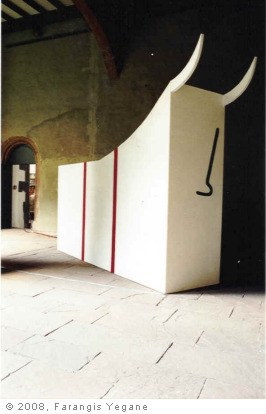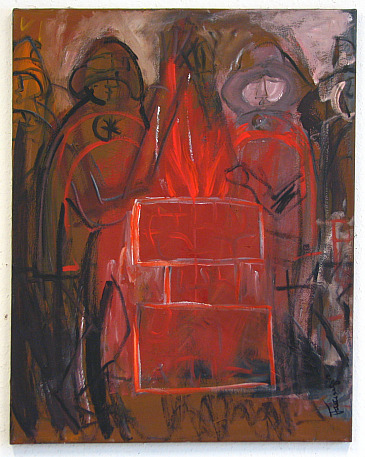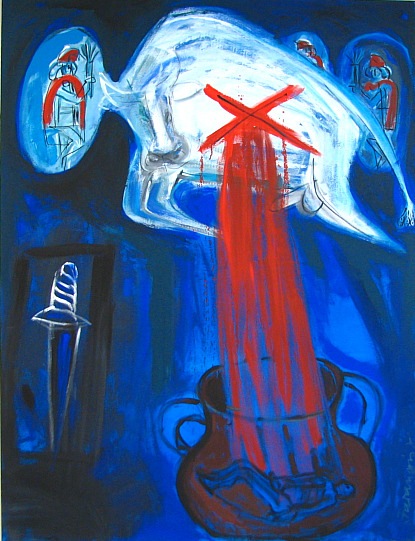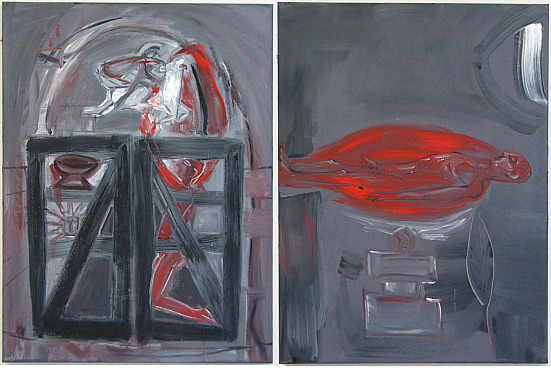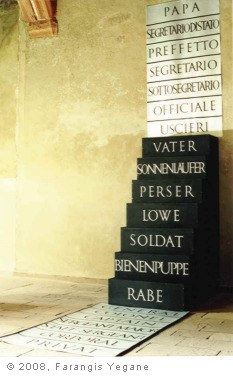mithras home -- part 1 of the exhibition
THE EXHIBITION < FOR EXAMPLE MITHRAS >
Farangis Yegane revives with her works - large paintings and installations relating to the Roman Mithras cult - new thoughts about questions pertaining to religious sciences. This is how the exhibition-project FOR EXAMPLE MITHRAS came in the year 1994 into life in the Karmeliter monastery in Frankfurt am Main, spatially directly connected with the archaeological museum.
With elements of light the artist created a connection between a designed white steer as a cult-object which visitors could enter, and the cult-picture of Mithras which has been found in the Roemerstadt in Frankfurt Heddernheim (see figure I. at the bottom of this page: fig. I).
With a Roman stone-altar borrowed from the museum, she brought together her painting showing Cautes and Cautopates standing next to a fire-altar (see figure II. at the bottom of this page: fig. II).
Other paintings had been designed by her as diptychs and triptychs, formats that are known from the Eastern Christian icon painting. A large dark-blue triptych shows an imagined concept of eternity with the bleeding white steer in the center part (see figure III. at the bottom of this page: fig. III).
On one diptych you can see on the left part the cult-room of a mithraeum (following a source of an image on a roman medal), and on the right part appears one lying while taking part in the sacred rites (see figure IV. at the bottom of this page: fig. IV).
A triptych in an upright format depicts in the upper picture controversially the crucified Christ as a victim that bleeds like the wounded steer in the middle picture, whose blood flows into a jug (see figure V. on the left).
As a spatial object Farangis Yegane drafted high black stairs which show with a white writing the seven major orders of the Mithras cult, starting from RAVEN ending with FATHER. To symbolize the presence of the higher and lower orders in the religious and secular hierarchies, which are still existent in our time, the artist shows at the footend of the stairs seven orders of precedence of the military and above the stairs seven orders of precedence from within the system of the catholic church (see figure VI. at the bottom of this page: fig.VI).
A big wooden object at the wall, covered with brown peat and made up of two parts that look like huge tablets carrying a holy decree, shows cut out on the upper right the shape of the sun and in the upper left the shape of the rising moon. A vertical red light connects both tablets. Upon stepping closer and viewing the object a play of light starts, beginning with a slow lighting up of the sun, then a slow disappearance of the sunlight. Following is the lighting up and disappearance of the moon, also in a slow rhythm. After this change of light, the red light in its shape of a rod suddenly sharply lightens up in the middle of the tablets, as if separating the calm succession of sun and moonlight. This red flashing rod resembles a penetrating exclamation mark, as if indicating a great upcoming danger (see figure VII. at the bottom of this page: fig.VII).
In the second part of FOR EXAMPLE MITHRAS (documented on: http://mithras.two.farangis.de/), Farangis Yegane will raise further questions, from within the context of this theme, about why in spite of our rational worldview we still are deeply touched by the cults and the rites of the different religions.

